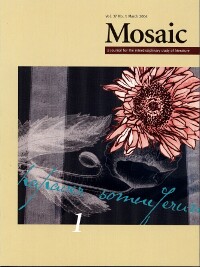Issue 37.1
Overview

General Issue
Published: March 2004
View the issue introduction or see the issue summary and contents below.
11 essays, totalling 192 pages
$15.00 CAD
This general issue of Mosaic offers the variety expected of an interdisciplinary journal, while notably making succinct comparisons, translations, and critical examinations of both expected and unexpected pairings. Look for essays examining literature and architecture; word and image; performance and artifice; A.S. Byatt and Vincent van Gogh; Mexican and Jewish cultural memory; and systems therapy and literary criticism. These examinations reveal dynamic and diverse relations in such works as Life a User’s Manual, The Reckless Moment, The Age of Innocence, and Sense and Sensibility.
Constructing the Architext: Georges Perec’s Life a User’s ManualPETA MITCHELL This essay argues that Georges Perec’s Life a User’s Manual—at once a novel, an apartment building, and a game of chess—articulates compellingly the confluence of literature and architecture that took place in the late twentieth century. | |
The Depth of the Deep End: The Noir Motif in The Reckless Moment and The Deep EndCHARLES SCRUGGS In The Reckless Moment, director Max Ophuls paired Lucia Harper with her African-American maid Sybil to critique America’s social arrangements. In the remake of Ophuls’s film The Deep End, directors Scott McGehee and David Siegel deleted the black maid to focus upon Margaret Hall’s social and metaphysical “homelessness.” | |
Emotion and the Jewish Historical Poems of Emma LazarusGREGORY EISELEIN The issue of emotion has long been used to trivialize Lazarus’s literary achievements. A systems-theory approach to emotion corrects this view by distinguishing her verse from other forms of affectively charged literature, illustrating more precisely the role of emotion in her work and clarifying the public-intellectual nature of her misunderstood project. | |
Looking through the Opera Glasses: Performance and Artifice in The Age of InnocenceCARMEN TRAMMELL SKAGGS In the historical context of Newland Archer’s New York, opera marks the opening of the winter season, delineates the inner circle of privilege, and exemplifies the wealth and leisure of this class. Serving as a structural frame for Wharton’s novel, opera illustrates the duality of the artifice of performance: the one on the stage and the one in the opera box. | |
Something of the Eternal: A.S. Byatt and Vincent van GoghSUE SORENSEN In refuting the commonly held idea that word and image exist as antagonists, art historian E.H. Gombrich influenced A.S. Byatt to investigate a fusion of visual and verbal language in her 1985 novel Still Life. Byatt’s scheme disintegrates when the characters most skilled in this double communication encounter not illumination, but death. | |
Phantastica: The Chemically Inspired Intellectual in Occult FictionBRENDA MANN HAMMACK This essay examines the representation of chemically altered intellectuals in works of occult fiction in the late nineteenth and early-twentieth centuries. Horrific dissolution was believed to afflict brain workers who resorted to psychoactive agents in order to boost productivity or to offset the symptoms of exhaustion. | |
Rosa Nissán: Cultural Memory and the Mexican Sephardic WomanElizabeth Coonrod Martínez The Sephardic Jewish community’s contribution within Mexican society (as well as the female’s within the Sephardic patriarchy) was overlooked in contemporary cultural portrayals until recently, when Rosa Nissán challenged the official story—both in Sephardic tradition and in the greater Mexican hegemonic system—with her recent stories that collect and portray the cultural memory of a people who are both Mexican and Jewish. | |
Theatre as Installation: Ann Hamilton and the Accretions of GestureCLARK LUNBERRY This essay presents descriptions of varied involvements with installations by the artist Ann Hamilton, interspersed by analyses on how each of them was viewed, moved within, and then finally recalled, reconstructed. In conjunction, the author examines—as theoretical and formal prototypes—the work of Samuel Beckett, especially his prescient, early study of Proust. | |
Hovering between Irony and Innocence: George MacDonald’s “The Light Princess” and the Gravity of ChildhoodAMY BILLONE During the Victorian period, George MacDonald deconstructed the innocence/experience dichotomy by revealing a link between innocence and irony. Reading MacDonald’s first children’s story “The Light Princess” alongside Baudelaire’s “De l’Essence du Rire,” this essay demonstrates how MacDonald gave children’s literature itself new weight. | |
Family-Systems Psychotherapy and Psychoanalytic Literary Criticism: A Comparative CritiqueJOHN V. KNAPP After considering some limitations of psychoanalytic criticism, this essay argues for family-systems psychotherapy as a developing paradigm for psychological literary criticism. The essay then analyzes differences between Freud’s “family romance” and family-system therapy’s “family dance.” | |
Historical Picturesque: Adapting Great Expectations and Sense and SensibilitySUSAN JOHNSTON Examining the reception of two film adaptations of nineteenth-century novels in the context of critical postmodernism, this essay investigates the obsession with fidelity and authenticity among critics. Noting links between the heritage film and the aesthetic of the picturesque, the author proposes Alfonso Cuarón’s counterpicturesque film as a model for heritage adaptations. |